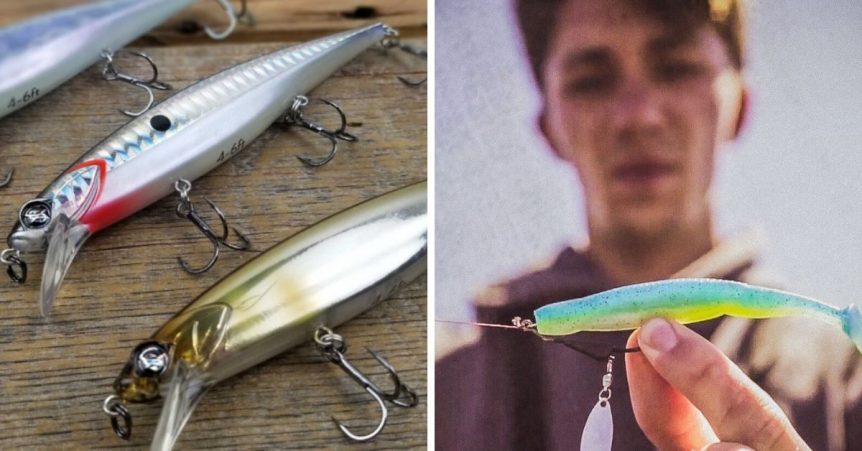2 Late Winter Bass Lures You NEED To Be Fishing
A bass’ metabolism slows way down in the winter, so the fish can go a few days without eating if it gulps down one big baitfish.
As winter progresses and the water gets colder, big baitfish are hardy enough to survive the cold water, but smaller baitfish such as threadfin shad and young gizzard shad start succumbing to the frigid water. During this shad die-off, a bass’ diet changes as the fish start targeting the easier meals of smaller shad that struggle to keep swimming. Matching the size of the dying baitfish becomes a key to catching bass during this time, so I downsize my lures to trigger more bites.

The lakes around my home are usually clear during the winter which is another reason to downsize my lures and tackle. The lakes also rarely freeze over so there are winter tournaments just about every weekend and some of the tournament competitors are even practicing throughout the week. This added fishing pressure makes winter bass even more finicky and prompts many anglers to downsize their baits.
Winter weather also calls for downsizing baits to coax lethargic bass into biting. After a winter storm passes through, the ensuing cold front featuring bluebird sky days and frigid, calm weather causes bass to suspend over winter sanctuaries and wait for a warming trend to start feeding again. Small lures that suspend or slowly sink are the best bet for tempting these inactive fish.
Here are two lures I recommend for downsizing when bass are keying on smaller baitfish in clear water.
Suspending Jerkbaits Crush

These lures are my all-time favorites for catching wintertime bass because the baits suspend at about the same depth as the fish are positioned in the water column. When the stickbait reaches its maximum depth, I can let it sit there in front of a bass for as long as 30 seconds to a minute. A couple of subtle twitches of the lure imitates a shad struggling to swim, which is an easy meal for a bass to capture.
Throughout most of the winter I favor a 4 1/2- or 5-inch suspending jerkbait I throw on baitcasting gear with 8- to 10-pound fluorocarbon line. When the winter drawdown drops the water level to its lowest point on my home lake of Lake of the Ozarks, the water is also close to the freezing point and there is usually ice in some of the coves. Bass become extremely sluggish then and tend to ignore my larger stickbaits so I downsize to 3-inch models, especially on the calm, sunny days after a cold front.
The short, lightweight stickbait is difficult to throw with baitcast gear so I tie the small lure on 8-pound monofilament and cast with spinning tackle. I prefer monofilament for my spinning reel because it flows off the spool slowly and smoothly whereas fluorocarbon line tends to jump off the spinning reel spool too quickly and creates too many line tangles. The short stickbait has a long bill that allows it to dive to the same depths as the larger models. After cranking the lure down to its maximum depth, I pause it and then try either a twitch-twitch-pause retrieve or slowly sweep the lure and pause it to trigger strikes from suspended bass.
Underspin For The Win

A heavyweight football or casting jig works great for bottom-hugging bass but these lures fall too fast through the strike zone of suspended bass. Combining a 5- or 6-inch swimbait and a 1/4-ounce underspin jig is an effective way to catch suspended wintertime bass, but when the water turns extremely cold savvy anglers downsize their baits. Some of the Table Rock Lake guides I know scale down to 1/8- or 1/16-ounce Roadrunners or other horsehead jigs to catch inactive wintertime spotted bass. They use either a horsehead jig with a marabou body or match the small underspin jig with a curly-tail plastic grub or 2- to 3-inch swimbait. During a recent trip with Table Rock Lake guide Pete Wenners, we caught suspended spotted bass on his home waters with a 1/8-ounce jighead and a 3-inch swimbait that we let slowly fall through the fish.
Match the lightweight underspin jig with a medium-action spinning rod and a reel filled with 6- to 8-pound line. The danger of a big bass breaking the light line is minimized when targeting suspended fish because you are usually fishing in open water and the sluggish fish usually have less fight in them. Make sure you set your drag loose enough to allow the fish to pull out some line if it surges to prevent line breakage.
Cast the underspin jig to bluffs where bass will be suspended 10 to 25 feet deep. Count down the lure as it falls to the depth you determine bass are suspending and then reel in the jig at a slow, steady pace.


